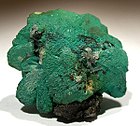
Malachite is a copper carbonate hydroxide mineral, with the formula Cu2CO3(OH)2. This opaque, green-banded mineral crystallizes in the monoclinic crystal system, and most often forms botryoidal, fibrous, or stalagmitic masses, in fractures and deep, underground spaces, where the water table and hydrothermal fluids provide the means for chemical precipitation. Individual crystals are rare, but occur as slender to acicular prisms. Pseudomorphs after more tabular or blocky azurite crystals also occur.
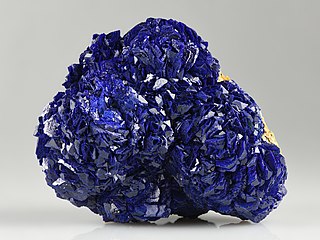
Azurite is a soft, deep-blue copper mineral produced by weathering of copper ore deposits. During the early 19th century, it was also known as chessylite, after the type locality at Chessy-les-Mines near Lyon, France. The mineral, a basic carbonate with the chemical formula Cu3(CO3)2(OH)2, has been known since ancient times, and was mentioned in Pliny the Elder's Natural History under the Greek name kuanos (κυανός: "deep blue," root of English cyan) and the Latin name caeruleum. Copper (Cu2+) gives it its blue color.

Clinoclase is a hydrous copper arsenate mineral, Cu3AsO4(OH)3. Clinoclase is a rare secondary copper mineral and forms acicular crystals in the fractured weathered zone above copper sulfide deposits. It occurs in vitreous, translucent dark blue to dark greenish blue colored crystals and botryoidal masses. The crystal system is monoclinic 2/m. It has a hardness of 2.5–3 and a relative density of 4.3. Associated minerals include malachite, olivenite, quartz, limonite, adamite, azurite, and brochantite among others.
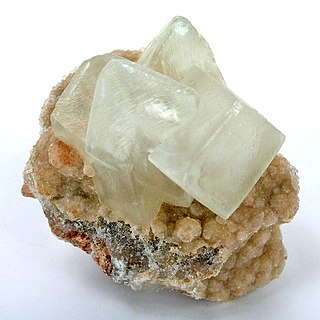
Smithsonite, also known as zinc spar, is the mineral form of zinc carbonate (ZnCO3). Historically, smithsonite was identified with hemimorphite before it was realized that they were two different minerals. The two minerals are very similar in appearance and the term calamine has been used for both, leading to some confusion. The distinct mineral smithsonite was named in 1832 by François Sulpice Beudant in honor of English chemist and mineralogist James Smithson (c. 1765–1829), who first identified the mineral in 1802.

Aurichalcite is a carbonate mineral, usually found as a secondary mineral in copper and zinc deposits. Its chemical formula is (Zn,Cu)5(CO3)2(OH)6. The zinc to copper ratio is about 5:4. Copper (Cu2+) gives aurichalcite its green-blue colors.

Cuprite is an oxide mineral composed of copper(I) oxide Cu2O, and is a minor ore of copper.

Dioptase is an intense emerald-green to bluish-green copper cyclosilicate mineral. It is transparent to translucent. Its luster is vitreous to sub-adamantine. Its formula is Cu6Si6O18·6H2O (also reported as CuSiO2(OH)2). It has a hardness of 5, the same as tooth enamel. Its specific gravity is 3.28–3.35, and it has two perfect and one very good cleavage directions. Additionally, dioptase is very fragile, and specimens must be handled with great care. It is a trigonal mineral, forming 6-sided crystals that are terminated by rhombohedra.

Chrysocolla ( KRIS-ə-KOL-ə) is a hydrous copper phyllosilicate mineral and mineraloid with the formula Cu
2 – xAl
x(H
2Si
2O
5)(OH)
4⋅nH
2O (x < 1) or (Cu, Al)
2H
2Si
2O
5(OH)
4⋅nH
2O).

Cyanotrichite is a hydrous copper aluminium sulfate mineral with formula Cu4Al2[(OH)12|SO4]·2H2O, also known as lettsomite. Cyanotrichite forms velvety radial acicular crystal aggregates of extremely fine fibers. It crystallizes in the monoclinic system and forms translucent bright blue acicular crystal clusters or drusey coatings. The Mohs hardness is 2 and the specific gravity ranges from 2.74 to 2.95. Refractive indices are nα = 1.588 nβ = 1.617 nγ = 1.655.

Caledonite, whose name derives from Caledonia, the historical name of its place of discovery (Scotland), is a richly colored blue-green sulfate-carbonate mineral of lead and copper with an orthorhombic crystal structure. It is an uncommon mineral found in the oxidized zones of copper-lead deposits.

Brochantite is a sulfate mineral, one of a number of cupric sulfates. Its chemical formula is Cu4SO4(OH)6. Formed in arid climates or in rapidly oxidizing copper sulfide deposits, it was named by Armand Lévy for his fellow Frenchman, geologist and mineralogist A. J. M. Brochant de Villiers.

Leadhillite is a lead sulfate carbonate hydroxide mineral, often associated with anglesite. It has the formula Pb4SO4(CO3)2(OH)2. Leadhillite crystallises in the monoclinic system, but develops pseudo-hexagonal forms due to crystal twinning. It forms transparent to translucent variably coloured crystals with an adamantine lustre. It is quite soft with a Mohs hardness of 2.5 and a relatively high specific gravity of 6.26 to 6.55.
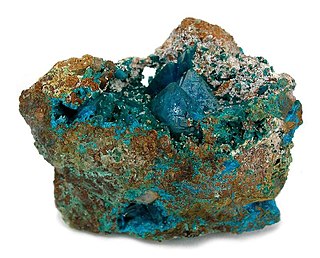
Liroconite is a complex mineral: Hydrated copper aluminium arsenate hydroxide, with the formula Cu2Al[(OH)4|AsO4]·4(H2O). It is a vitreous monoclinic mineral, colored bright blue to green, often associated with malachite, azurite, olivenite, and clinoclase. It is quite soft, with a Mohs hardness of 2 - 2.5, and has a specific gravity of 2.9 - 3.0.

Shattuckite is a copper silicate hydroxide mineral with formula Cu5(SiO3)4(OH)2. It crystallizes in the orthorhombic – dipyramidal crystal system and usually occurs in a granular massive form and also as fibrous acicular crystals. It is closely allied to plancheite in structure and appearance.

Conichalcite, CaCu(AsO4)(OH), is a relatively common arsenate mineral related to duftite (PbCu(AsO4)(OH)). It is green, often botryoidal, and occurs in the oxidation zone of some metal deposits. It occurs with limonite, malachite, beudantite, adamite, cuproadamite, olivenite and smithsonite.

Ashburtonite is a rare lead copper silicate-bicarbonate mineral with formula: HPb4Cu2+4Si4O12(HCO3)4(OH)4Cl.

Tsumebite is a rare phosphate mineral named in 1912 after the locality where it was first found, the Tsumeb mine in Namibia, well known to mineral collectors for the wide range of minerals found there. Tsumebite is a compound phosphate and sulfate of lead and copper, with hydroxyl, formula Pb2Cu(PO4)(SO4)(OH). There is a similar mineral called arsentsumebite, where the phosphate group PO4 is replaced by the arsenate group AsO4, giving the formula Pb2Cu(AsO4)(SO4)(OH). Both minerals are members of the brackebuschite group.

Diaboleite is a blue-colored mineral with formula Pb2CuCl2(OH)4. It was discovered in England in 1923 and named diaboleite, from the Greek word διά and boleite, meaning "distinct from boleite". The mineral has since been found in a number of countries.
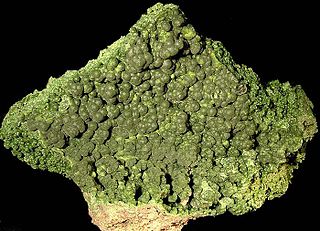
Mottramite is an orthorhombic anhydrous vanadate hydroxide mineral, PbCu(VO4)(OH), at the copper end of the descloizite subgroup. It was formerly called cuprodescloizite or psittacinite (this mineral characterized in 1868 by Frederick Augustus Genth). Duhamelite is a calcium- and bismuth-bearing variety of mottramite, typically with acicular habit.

Teineite is a tellurite mineral with the formula Cu(TeO3). 2 H2O. It has a Mohs hardness of 2.5 and it comes in many different shades of blue, ranging from cerulean blue to bluish-gray. The mineral millsite has the same chemical composition, but crystallizes in the monoclinic system, while teineite crystallizes in the orthorhombic system.




